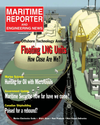
Page 50: of Maritime Reporter Magazine (April 2005)
The Offshore Industry Anual
Read this page in Pdf, Flash or Html5 edition of April 2005 Maritime Reporter Magazine
50 Maritime Reporter & Engineering News
Unless you are South Korean,
Japanese or Chinese, shipbuilding in the spring of 2005 is not an easy livelihood.
According to Lloyd's Fairplay these three countries have captured 61 percent of the worlds order book. North and
South America have three percent com- bined. It is quite a bleak picture.
It is even more alarming when you consider that fortress North America is surrounded on three sides by major oceans. Historically, Canadians and
Americans have relied on these oceans to provide a physical barrier from the political upheavals and wars endemic in
Europe and Asia Pacific.
These oceans were the roads that pro- vided the food and industrial material that allowed the allies to prevail in two world wars. They are now the roads that allow our two nations to import the strategic necessities that keep our economies strong. It is self evident that ships will not be replaced as the primary tools for the movement of the world's commerce for the foreseeable future.
A Little History
In 1938 Canada's navy comprised a handful of ships and barely 1,000 per- sonnel with no shipbuilding industry to speak of. By 1945, Canada's Navy included 775 vessels and 90,000 person- nel. Some 30,000 ships had been refit- ted, converted and repaired in Canadian yards and 65,000 persons were employed in the shipbuilding industry.
From 1945 until today there has been a slow and steady decline in the size of the industry. Today there are between 5,000 and 8,000 persons directly employed in the shipbuilding industry.
What has happened since the heady days after the Second World War?
Essentially supply has outstripped demand for ships. Global capacity has increased with little regard for the requirements of the market and every- where government interference and sub- sidies have been the order of the day.
South Korea increased its capacity from nine million deadweight to 27 million deadweight tons in the nineties. China has captured 15% of the international market in only ten years, is building the largest shipyard in the world and plans to be the world's number one shipbuild- ing nation by 2015. I think it is a safe guess that they are not doing this on their profits from shipbuilding alone.
The shipbuilding industry in Canada has found itself caught in the middle. In the mid eighties government/industry initiatives reduced Canada's capacity by 40 percent. Shipbuilders were left with three policies to assist the industry.
First, Canadian shipowners who pur- chased offshore for use in the domestic trade were required to pay an import tar- iff of 25%. Second, shipowners who did build in Canada were entitled to acceler- ated depreciation on their asset. Third, government fleets were to be construct- ed, repaired and refitted in Canada.
Meanwhile, with the failure of the
OECD agreement to eliminate ship- building subsidies, the world's shipyards flourished or failed in accordance with the amount of subsidy and protection they received from their governments.
In 1994, the North American Free
Trade Agreement (NAFTA) was launched. In the first four years of
NAFTA, trade within North America increased by about 75% and it was con- sidered a resounding success.
Unfortunately the Jones act was exempt- ed from NAFTA and the American ship- building market closed to Canada.
Ironically the reverse is not true and our market remains open to our American friends. A close look at our geography shows immediately why the American market is important to Canadian ship- builders.
A New Millennium
Perceptions of ships as part of an old outdated economy not worthy of a
Canada of the 21st century were the norm in the Canadian government.
Except for those few persons who live on the coasts, there is little appreciation, by the average Canadian, of the impor- tance of marine transportation to the economy. There was and still is even less knowledge of the high-tech com- plexity of today's ships.
In 2001 the then Minister of Industry,
Brian Tobin, commissioned the National
Partnership Project to examine the ship- building industry and make practical recommendations as to how to get it moving again.
The report made 36 recommendations in 10 different areas. The report was submitted in March 2001 and responded to by government in June of the same year, which has to be a world record.
The outcomes of that report are the foundation of Canada's shipbuilding structure and policy today. The Key issues accepted by the government were: • A marine branch with responsibility for shipbuilding was established in gov- ernment; A Structured Financing Facility was introduced to help Canadian owners finance ships built in Canada; A shipbuilding and Marine advisory committee that examines issues and makes recommendations to the Minister was established; Government R&D programs were opened to the shipbuilding industry; A technology road map was author- ized and completed; The report's recommendations on federal fleet procurement were given
Country Focus: Canada
Shipbuilding in Canada
Photo Cour tesy of Ir ving Shipbuilding
MR APRIL 2005 #7 (49-56).qxd 4/1/2005 5:13 PM Page 2

 49
49

 51
51
